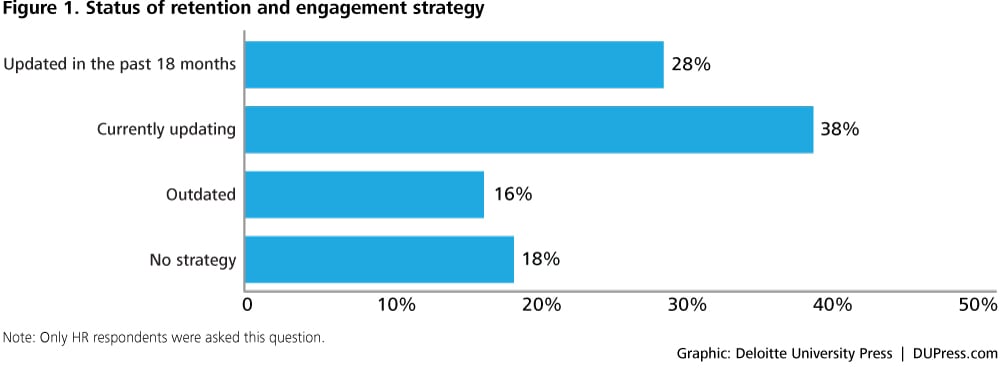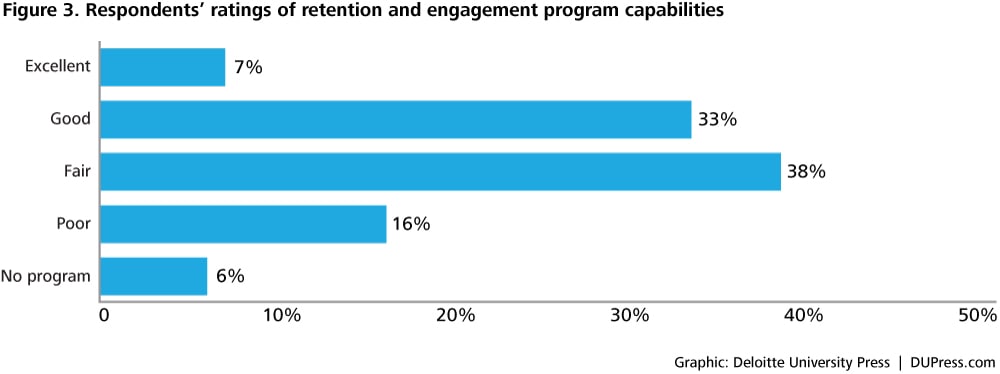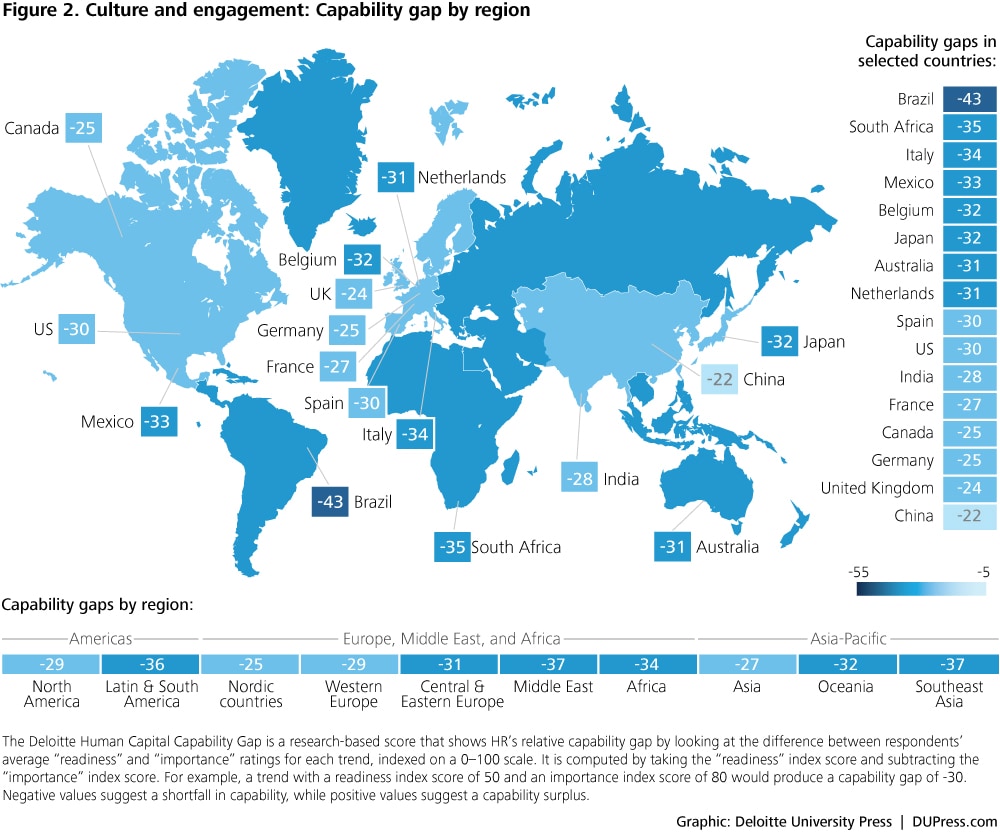Culture and engagement has been saved

Culture and engagement The naked organization
28 February 2015
Employee engagement and culture are now business issues, not just topics for HR to debate. And there’s no place for organizations to hide.
- In an era of heightened corporate transparency, greater workforce mobility, and severe skills shortages, culture, engagement, and retention have emerged as top issues for business leaders. These issues are not simply an HR problem.
- Culture and engagement is the most important issue companies face around the world. 87 percent of organizations cite culture and engagement as one of their top challenges, and 50 percent call the problem “very important.”
- Organizations that create a culture defined by meaningful work, deep employee engagement, job and organizational fit, and strong leadership are outperforming their peers and will likely beat their competition in attracting top talent.
Explore
Explore the interactive trends dashboard
Learn more about culture and engagement
Create and download a custom PDF of the Human Capital Trends 2015 report.
Today’s organizations live in the Glassdoor era. Every corporate decision is immediately publicly exposed and debated. Once-private issues are now posted online for every employee—and every potential employee—to read. An organization’s culture—which can be loosely defined as “the way things work around here”—is increasingly visible for all the world to see.
 Given the harsh spotlight of this new transparency, an organization’s culture can become a key competitive advantage—or its Achilles’ heel. Culture and engagement are now business issues, not just topics for HR to debate. And there’s no place for organizations to hide.
Given the harsh spotlight of this new transparency, an organization’s culture can become a key competitive advantage—or its Achilles’ heel. Culture and engagement are now business issues, not just topics for HR to debate. And there’s no place for organizations to hide.
This year, employee engagement and culture issues exploded onto the scene, rising to become the No. 1 challenge around the world in our study.1 An overwhelming 87 percent of respondents believe the issue is “important,” with 50 percent citing the problem as “very important”—double the proportion in last year’s survey. Two-thirds (66 percent) of HR respondents reported that they are updating their engagement and retention strategies (figure 1). Along with decreasing readiness, our data also showed substantial capability gaps in engagement and culture across countries and regions (figure 2).

Research shows that in most companies, engagement is low. According to the Gallup polling firm, only 13 percent of the global workforce is “highly engaged.”2 Upwards of half the workforce would not recommend their employer to their peers.3
Despite this challenge, a substantial proportion of the respondents in this year’s survey (22 percent) report that their organizations have either a poor program to measure and improve engagement, or no program at all. Only 7 percent rate themselves excellent at measuring, driving, and improving engagement and retention (figure 3). And only 12 percent believe their organizations are excellent at effectively driving the desired culture.

This is a new and systemic problem for organizations worldwide. Why has it become so acute?
- Employees are now like customers; companies have to consider them volunteers, not just workers: As the job market has heated up and new technologies have exploded, power has shifted from the employer to the employee. Websites like Glassdoor, LinkedIn, Facebook, and others not only increase transparency about a company’s workplace; they make it far easier for employees to learn about new job opportunities and gain intelligence about company cultures.
- Leaders lack an understanding of and models for culture: Culture is driven from the top down. Yet most executives cannot even define their organization’s culture, much less figure out how to disseminate it through the company.
- The new world of work changes the way we engage people: The world of work is very different from and more complex than it was only a few years ago. Employees today work more hours and are nearly continuously connected to their jobs by pervasive mobile technologies. They work on demanding cross-functional teams that often bring new people together at a rapid rate. Flexibility, empowerment, development, and mobility all now play a big role in defining a company’s culture.
- Employees’ motivations have changed: Today’s workers have a new focus on purpose, mission, and work-life integration.4 Research shows that a variety of complex factors contribute to strong employee engagement, including job design, management, work environment, development, and leadership.5 Today, more than twice as many employees are motivated by work passion than career ambition (12 percent vs. 5 percent), indicating a need for leadership to focus on making the work environment compelling and enjoyable for everyone.6
Culture and engagement is no longer an arcane topic owned by HR. It is now an imperative for every leader and every executive in the organization. Many studies now show that highly engaged companies can hire more easily, deliver stronger customer service, have the lowest voluntary turnover rates, and be more profitable over the long run.7
Google, a highly rated “best place to work” in many studies, focuses heavily on culture.8 The company regularly measures dozens of factors to understand what makes people productive and happy. This research has shaped Google’s workplace culture in myriad ways—from the company’s open workplace design to the provision of free gourmet food and on-site laundry services for employees.
Although culture and engagement play such a critical role in business performance, most organizations do a poor job of measuring their achievements or shortcomings. Historically, companies have relied on annual engagement surveys, often costing hundreds of thousands of dollars and taking months to deploy. And very few companies have a process or tools to measure culture and learn where it is strong, weak, or inconsistent. At a time when corporate cultures are being continuously debated, shaped, and redefined on social networks, the once-a-year survey is perilously obsolete.
While most leaders are measured on the basis of business results, organizations must begin holding leaders accountable for building a strong and enduring culture, listening to feedback, and engaging and retaining their teams.
Fortunately, new tools are emerging to provide organizations with real-time sentiment and employee feedback. A new breed of vendors offers pulse survey tools, employee sentiment management tools, culture assessment tools, and real-time employee monitoring tools to help leaders and supervisors rapidly assess when engagement is high and when problems are arising.9 These new tools make it possible for organizations to monitor employee sentiment with the same level of rigor and speed as they measure customer sentiment.10
Ultimately, the issues of culture and engagement are driven by leadership. Companies pushing aggressive growth plans, experiencing financial stress, or going through layoffs or mergers often see a radical shift in culture. While most leaders are measured on the basis of business results, organizations must begin holding leaders accountable for building a strong and enduring culture, listening to feedback, and engaging and retaining their teams.
HR should also understand the impact of performance management, work-life balance, and flexibility on engagement. While management practices once pushed companies toward a highly competitive performance management process, in 2015, many companies are finding that pressure and competition often lead to high turnover and ultimately poorer business results.
Lessons from the front lines
A series of events at one global financial services company not only fed a negative public perception of the company, but also generated a lack of trust internally. To turn the organization around, the company launched a five-year transformation program, a key component of which was to build a sustainable, values-driven culture across the organization.
This cultural transformation had three key distinguishing principles that were critical to the program’s success:
- Leadership drives culture which in turn drives performance: Company leaders should drive the change and be highly accountable
- Processes, policies, and systems should be congruent with the company’s new purpose and underpinning values
- The results should be measurable and reported both internally and externally, providing a highly visible yardstick of progress
To jump-start the transformation, HR introduced a series of leadership and development programs to support employees in being willing and able to live the new values. There was an initial focus on informing, engaging, and empowering senior leaders and culture carriers to promote the company’s new values, equipping them with the necessary insight, knowledge, and tools to drive the change. All processes, policies, and systems were then aligned with the new culture, with performance management, talent management, recognition, and learning all transformed to reflect the new values and behaviors. The company also deployed a cultural assessment tool to understand and measure the conditions for successful transformation.
These activities had a strong and measurable business impact. The result: an improved public reputation; an aligned senior leadership group with culture at the top of their agenda; a growth in trust both internally and externally; and stronger employee engagement and commitment to the organization’s new culture and values.
Where companies can start
- Engagement starts at the top: Make engagement a corporate priority, and modernize the process of measuring and evaluating engagement throughout the company. Benchmark the company, strive for external recognition as validation of efforts, and reinforce to leadership that the engagement and retention of people is their No. 1 job.
- Measure in real time: Put in place real-time programs to evaluate and assess organizational culture, using models or tools to better understand where it is strong, where it is weak, and how it really feels to workers.
- Make work meaningful: Focus on leadership, coaching, and performance management to help employees make their work meaningful. Reinforce the importance of a coaching and feedback culture, and teach leaders how to be authentic and transparent.
- Listen to the Millennials: Their desires, needs, and values will shape the organization’s culture over the next 10 years.
- Simplify the work environment: Read our research in this report on the simplification of work to help reduce the burden of today’s 24/7 work environment.
Bottom line
The old adage “culture eats strategy for breakfast” applies to every organization today. Business and HR executives must understand that highly engaged companies attract the best talent, have the lowest voluntary turnover rates, and are more profitable over the long run.11 Companies should use 2015 as a time for change. By focusing on driving engagement through the right corporate culture, companies can improve execution, retention, and financial performance.
© 2021. See Terms of Use for more information.



